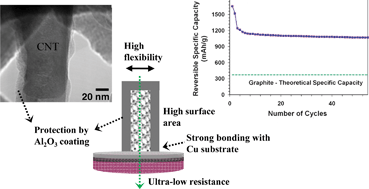Ultrathin alumina-coated carbon nanotubes as an anode for high capacity Li-ion batteries†
Abstract

* Corresponding authors
a
Department of Mechanical and Materials Engineering, Florida International University, Miami, FL, USA
E-mail:
choiw@fiu.edu
Fax: +1 305 348 1932
Tel: +1 305 348 1973
b Department of Energy Engineering, Hanyang University, Seoul, Korea
c Department of Materials Science and Engineering, University of North Texas, Denton, TX, USA
d Department of Materials Science and Engineering, Hanyang University, Seoul, Korea

 Please wait while we load your content...
Something went wrong. Try again?
Please wait while we load your content...
Something went wrong. Try again?
I. Lahiri, S. Oh, J. Y. Hwang, C. Kang, M. Choi, H. Jeon, R. Banerjee, Y. Sun and W. Choi, J. Mater. Chem., 2011, 21, 13621 DOI: 10.1039/C1JM11474C
To request permission to reproduce material from this article, please go to the Copyright Clearance Center request page.
If you are an author contributing to an RSC publication, you do not need to request permission provided correct acknowledgement is given.
If you are the author of this article, you do not need to request permission to reproduce figures and diagrams provided correct acknowledgement is given. If you want to reproduce the whole article in a third-party publication (excluding your thesis/dissertation for which permission is not required) please go to the Copyright Clearance Center request page.
Read more about how to correctly acknowledge RSC content.
 Fetching data from CrossRef.
Fetching data from CrossRef.
This may take some time to load.
Loading related content
